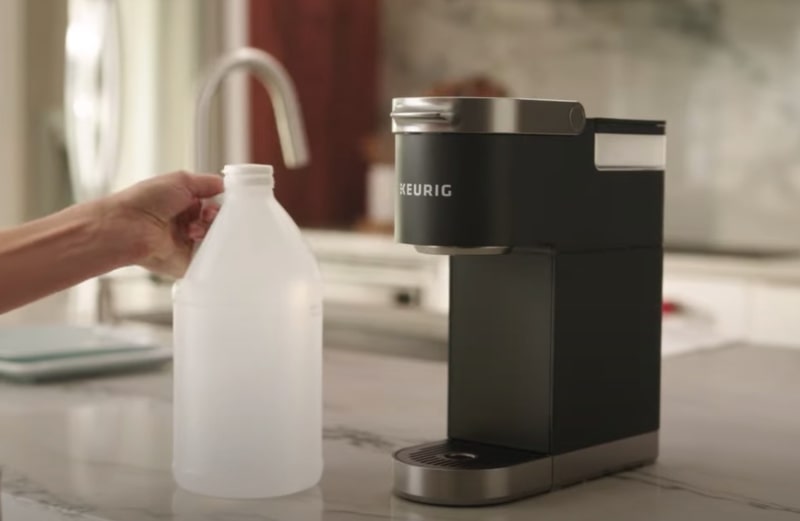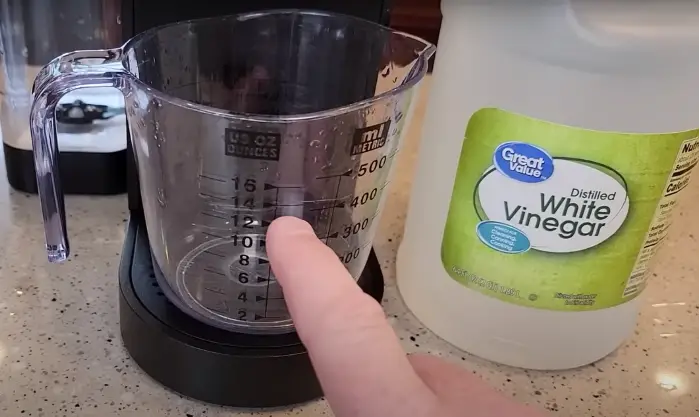If you’ve ever pondered whether the household staple, vinegar, can effectively combat the mineral buildup in your Keurig, you’ve come to the right spot. In this article, we’ll delve into the details of employing vinegar as a descaling solution for your Keurig machine. So, can you truly descale a Keurig with vinegar? Let’s delve in to discover the answer.
Does Vinegar Descaling Harm Your Keurig?
A common concern among Keurig users is whether descaling their coffee maker with vinegar can cause harm. Let’s delve deeper into this topic to address any lingering doubts.
While vinegar is indeed acidic, which may raise concerns, it’s crucial to understand that when used correctly, vinegar poses minimal risk to your Keurig machine. In fact, it can effectively extend the life of your brewer by preventing mineral buildup and improving performance.
Keurig machines are designed to withstand occasional vinegar descaling without significant harm. The materials used in their construction can generally handle the acidity of vinegar when used within recommended guidelines.
However, to ensure that using vinegar for descaling is safe for your specific Keurig model, always consult Keurig’s official guidelines or refer to our in-depth descaling instructions. These resources provide valuable insights into the compatibility and safety of vinegar descaling for your particular brewer.
Remember, moderation is key. Overusing vinegar for descaling or letting it sit in your machine for extended periods can potentially lead to harm. It’s essential to follow recommended descaling frequencies and time frames to enjoy the benefits of vinegar without adverse effects.
With proper care and maintenance, vinegar can be a valuable tool in keeping your Keurig in excellent working condition for years to come.
Can You Descale a Keurig with Vinegar if It’s Under Warranty?
Whether utilizing vinegar for descaling will nullify your machine’s warranty is another common concern among Keurig users. The reassuring information is that descaling your Keurig with vinegar is regarded as regular maintenance and typically won’t void your warranty when done correctly.
Keurig, like many other appliance manufacturers, recognizes that regular descaling is essential to keep their machines in optimal working condition. Mineral buildup from water can affect the performance and longevity of your Keurig, so they encourage users to descale as part of regular maintenance.
Benefits and Drawbacks of Using Vinegar for Descaling
Benefits of Using Vinegar
- Affordability: Vinegar is a pantry staple, and you probably already have it in your kitchen. This makes it a budget-friendly choice for descaling, saving you money compared to purchasing commercial descaling solutions.
- Readily Available: Vinegar is easy to find in most grocery stores. Its accessibility means you can start descaling your Keurig without making a special trip to the store.
- Effective at Removing Mineral Buildup: Vinegar’s acidity helps break down and dissolve mineral deposits inside your Keurig. It can be surprisingly effective at restoring your brewer’s performance by eliminating clogs and blockages caused by scale buildup.
Drawbacks of Using Vinegar
- Strong Odor: One of the most common drawbacks of using vinegar is the pungent odor it can leave behind. Some users find that their first few cups of coffee after descaling have a faint vinegar taste. However, this can be mitigated by thoroughly rinsing your Keurig.
- Potential Damage if Not Used Properly: Vinegar is acidic, which means it can corrode certain materials over time. If used excessively or too frequently, it could damage the rubber and plastic components of your Keurig. It’s essential to follow proper dilution instructions and rinse your machine thoroughly after descaling to prevent any harm.
Minimizing Risks and Choosing the Right Solution
To enjoy the benefits of using vinegar while minimizing its drawbacks, follow these tips:
- Thorough Rinsing: After descaling with vinegar, run multiple rinsing cycles with fresh water to eliminate any residual odor or taste.
- Moderation: Don’t overuse vinegar for descaling. Stick to your manufacturer’s recommendations, which often suggest descaling every 3-6 months or when prompted by your machine’s descale indicator.
- Consider Alternatives: If you’re concerned about the drawbacks of vinegar, explore commercial descaling solutions specifically designed for Keurig machines. These products are formulated to be effective while minimizing odor and potential harm.

Can I Run Straight Vinegar Through My Coffee Maker?
The Power of Undiluted Vinegar: Exploring Its Descaling Effectiveness
Undiluted vinegar, specifically white vinegar, is a potent household item that has gained a reputation for its ability to tackle mineral deposits and limescale in various appliances, including coffee makers. When it comes to descaling your coffee maker, undiluted vinegar can be a highly effective option. Its acidity helps break down and dissolve the mineral buildup that can affect the performance of your coffee maker.
Manufacturer’s Choice: Why Keurig Recommends Undiluted Vinegar
Keurig, the well-known coffee maker manufacturer, often recommends undiluted white vinegar as the preferred descaling solution for its machines. This is due to the vinegar’s effectiveness in removing mineral deposits, which can clog the internal components of the coffee maker over time. When used properly, undiluted vinegar can restore your coffee maker to its optimal performance, ensuring that you continue to brew delicious cups of coffee.
Another important reason Keurig recommends undiluted vinegar is its cost-effectiveness and accessibility. White vinegar is readily available at most grocery stores and is significantly cheaper than commercial descaling solutions. Using vinegar is not only effective but also an economical choice for maintaining your coffee maker’s performance.
Clearing the Air: Managing Odor and Taste When Using Undiluted Vinegar
One concern some users have when descaling with undiluted vinegar is the strong odor it can produce. Undoubtedly, vinegar has a pungent smell that can linger in your coffee maker and affect the taste of your brew if not properly rinsed. To mitigate this, follow the manufacturer’s instructions for the descaling process carefully.
After descaling with undiluted vinegar, it’s essential to rinse your coffee maker thoroughly. Run several cycles of plain water through the machine to flush out any remaining vinegar residue. This will help eliminate the strong odor and ensure that your coffee tastes as delicious as ever. Remember to be patient and thorough during the rinsing process to avoid any lingering vinegar taste.
How much white vinegar do I use to descale my coffee maker?
There’s no need to dilute white vinegar with water for descaling; you can use undiluted white vinegar for this purpose. Undiluted vinegar proves highly effective in dissolving mineral deposits and limescale that accumulate in your coffee maker over time.
For a standard descaling process, start by pouring undiluted white vinegar into the water reservoir. Fill it up to its maximum capacity, ensuring that the entire internal system of your coffee maker is treated with the vinegar solution.

How long do you leave vinegar on for descaling?
The duration for which you should leave vinegar in your coffee maker for descaling depends on the specific descaling process you are following. Typically, the vinegar solution should be left in the coffee maker for about 4 hours.
During this time, the vinegar works to dissolve and loosen mineral deposits and limescale that have accumulated in the machine. This allows for a more effective descaling process.
What happens if you leave vinegar for too long?
Leaving undiluted vinegar in your coffee maker for an extended period beyond the recommended time can potentially lead to unintended consequences. While vinegar is effective at removing mineral buildup, extended exposure can cause damage to certain components, particularly rubber gaskets and seals.
Prolonged contact with vinegar can deteriorate these rubber parts, leading to leaks and potential issues with your coffee maker’s performance. To avoid this, always adhere to the recommended descaling time provided in your coffee maker’s user manual or the manufacturer’s guidelines.
How many times should I run water through the coffee maker after vinegar?
After the descaling process with vinegar, it’s crucial to rinse your coffee maker thoroughly to remove any residual vinegar taste or odor. The number of times you should run water through the machine for rinsing can vary, but it’s generally recommended to perform at least three to four rinsing cycles.
During these rinsing cycles, use plain water in the water reservoir, without any vinegar. Run the machine through a brewing cycle each time, allowing the water to flow through all the internal components. Discard the hot water after each cycle, ensuring that it’s free from any vinegar remnants. This helps clear out any remaining vinegar and ensures your coffee tastes fresh and vinegar-free.
Final Words
To sum it up, vinegar can be your go-to solution for descaling your Keurig. It’s not only budget-friendly but also highly effective when used correctly. So, if you’ve been wondering whether you can descale a Keurig with vinegar, the answer is a resounding yes. Give it a try, and enjoy consistently great-tasting coffee from your Keurig machine.
💡 More Descaling guides on Different Keurig Modes:
👉 How to descale keurig slim?
👉 How to descale keurig slim with vinegar?
👉 How to descale keurig mini?
👉 How to descale keurig duo?
👉 How to descale keurig supreme?
👉 How to descale keurig supreme with vinegar?
👉 How to descale keurig express?
